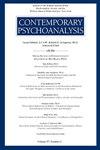The Difficulty to Reside: On Analytically Oriented Psychotherapy With The Homeless
IF 0.2
4区 心理学
Q4 PSYCHIATRY
引用次数: 0
Abstract
Abstract This article illustrates analytically oriented psychotherapy with the homeless. The concept “Difficulty to Reside” is introduced to describe the inherent emotional difficulty of many homeless people to tolerate the idea of a home as well as an actual physical residence. This is not only the difficulty of bearing a home in the physical sense, but the difficulty of being within the envelope of a close relationship, and even a failure of the individual to be close to themself. Three layers of the difficulty to reside are noted, by means of clinical examples: the autistic-schizoid layer, the psychotic layer, and the layer of trauma, personality disorders and substance abuse. Modes of intervention are suggested. The therapist’s mind as a metaphorical home for the patient is illustrated. The emotional dynamics of treating the homeless are analogized to Calvino’s “Invisible Cities,” as alternation between destruction and construction. The homelessness in the therapist’s psyche is emphasized. Finally, the metaphor of “the Edge of Chaos Theory” (physics/biology) is presented as an area of encounter between homeless patient and therapist.居住的困难:论以分析为导向的无家可归者心理治疗
本文阐述了分析导向的心理治疗与无家可归者。“居住困难”的概念被引入来描述许多无家可归的人固有的情感困难,以容忍一个家的想法以及一个实际的物理住所。这不仅是在物理意义上拥有一个家的困难,而且是在亲密关系的范围内的困难,甚至是个人无法接近自己的困难。通过临床实例,指出了生活困难的三个层次:自闭症-精神分裂层,精神病层,创伤层,人格障碍和药物滥用。提出了干预方式。对病人来说,治疗师的心灵是隐喻性的家。对待无家可归者的情感动态被类比为卡尔维诺的“看不见的城市”,作为破坏与建设之间的交替。强调治疗师心理上的无家可归。最后,“混沌理论的边缘”(物理/生物学)的隐喻被呈现为无家可归的病人和治疗师之间的相遇区域。
本文章由计算机程序翻译,如有差异,请以英文原文为准。
求助全文
约1分钟内获得全文
求助全文

 求助内容:
求助内容: 应助结果提醒方式:
应助结果提醒方式:


